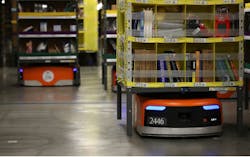As technologies for handling materials begin to incorporate the promises of artificial intelligence and the Internet of Things (IoT), new tools promise to make life more magical for the wizards in your warehouse. Here are some of the technologies that could reshape how the picking and packing is done.
Robots. Somehow all discussions of future technology these days get back to robots, so let’s start there. The most advanced warehouses, most visibly the high-volume consumer-oriented e-commerce fulfillment centers run by Amazon and the like, are pushing ahead with technologies to simplify the work for warehouse workers by automating the movement of goods with complex systems of robot transporters and high-speed carousels.
It’s been four years since Amazon spent $775 million to acquire Kiva Systems, a Massachusetts-based startup that makes warehouse robots and software. Now more than 30,000 Kiva robots roam the aisles of Amazon’s fulfillment centers to help speed up warehouse operations and decrease labor costs.
Fancy and futuristic as robot assistants may be, they’re unlikely to be useful anytime soon in a typical electrical distributor’s 5,000-10,000 square foot warehouse. Even in large central distribution centers, the limitations of robotics thus far — they are pretty much confined to ground-level scurrying-about — make the systems harder to justify in terms of cost savings or improved accuracy unless you’re dealing with Amazon-scale flow.
That said, the Consumer Electronics Show (CES) in Las Vegas in January featured many offerings that suggest the day is not that far off when we’ll all be able to walk down the street with a personal robot following behind, carrying our bags. If robots do become ubiquitous they’ll certainly find use in the warehouse too.
Wearable technology. Much more intriguing and potentially useful systems may be the devices and systems that will turn your warehouse wizards into technologically integrated super-beings by equipping them with devices to make their jobs easier, faster and more precise. You may have cyborgs in your warehouse sooner than you thought.
Smart glasses, voice control headsets, smart watches and other wearables from wrist-mounted computers to, someday, uniforms of electronic metamaterials will be integrated with warehouse management and indoor location tracking systems to enrich the data available to inform and guide your warehouse workers through the picking process more swiftly. Hands-free displays and controls will provide a significant boost in productivity, an estimated 30 percent according to vendors of the technologies.
With a little imagination we may see a day when a counter salesperson can not only track the progress of an order for a will-call customer but let the customer and managers see what the picker sees.
In an article for SupplyChain247, Patrick Van den Bossche, partner with A.T. Kearney, pointed to efficiency increases, especially for deliveries and field crews. “(Pick by vision) also increases efficiency by eliminating paper or stationary terminals, and increases accuracy by visually confirming via scanning. Another smart glasses application is remote video conferencing, which is emerging in field service industries because it increases asset uptime and reduces support cost by remotely supporting operators using cameras, instead of having them wait on a technician to arrive. Smart glasses can also decrease training lead times, improve quality rates, and reduce cycle times in assembly operations.”
Augmented reality. Wearable technology will pave the way for augmented reality applications. The silly Pokémon Go craze that swept through the world last year provides a hint of technology that could make warehouse work both efficient and fun. A system that can overlay images onto a view of the real world and give users a way to interact with those superimposed images has clear applications in the well-organized and defined space of a warehouse. The ability of sports broadcasters to superimpose the scrimmage and first-down lines on a football field may be a more intuitive example of how augmented reality may work in the warehouse, with bin locations lighting up for the pick and adjusting inventory immediately when the fitting is grasped with a digital glove.
Until digital augmented reality becomes widely useful there are interim technologies already proving their worth in the warehouse. Pick to light systems have been around for several years and pick to voice systems are finding widespread applications in the warehouse.
Artificial intelligence. Many are looking to artificial intelligence to drive the next wave of process efficiency improvements. Warehouse management systems’ constantly evolving capabilities in forecasting replenishment cycles, routing and staging optimization and integration with enterprise resource planning (ERP) intelligence systems promise continuing advances applicable on the warehouse floor.
The promise of AI comes in its ability to learn over time and improve processes based on real world data. Combining sensor networks such as those in your LED connected-lighting systems with data analysis, a warehouse AI system will be able to learn patterns unique to your facility and optimize order flow based on a broader range of parameters (by knowing things like the charge left on a forklift or the location of an oddball item in your inventory, or knowing to route pickers around the owner’s bass boat parked on a trailer in the far corner of the loading dock) than all but your best-trained and most experienced warehouse aces.
In a recent blog entry, supply chain software provider Kinaxis looked into uses of AI in the supply chain and described its increasing power in decision making.
“AI and prescriptive analytics in supply chain could lead to revolutionary breakthroughs, including automating the decision process. This concept goes far beyond just having software that runs scenarios and shows you ranked results of their outcomes, but lets the machines (in this case computers) actually make the decision entirely, and then filter that control command down through the rest of the supply chain. It’s opening the door for a conversation around optimization versus human judgement.”
RFID and printable electronics. The electrical industry has never fully embraced radio-frequency identification (RFID) tags as a replacement for bar codes, largely due to the cost of implementation versus the savings created. The next step beyond RFID may change the picture.
At the National Association of Wholesaler-Distributors (NAW) Executive Summit last month, keynote speaker Michael Steep, senior VP of global business development for PARC and an expert on technology disruptions, led attendees on a whirlwind tour of emerging technologies ranging from metamaterials to “contextual intelligence.” Steep described how “peel and stick” printed electronics that can place a rudimentary circuit including sensors and antennae directly on products will allow users to essentially talk to their inventory instead of having to have data about its characteristics, condition and whereabouts loaded separately into the system. Such inexpensive sensors, if widely distributed, could tell not just about the product but about the humidity, temperature, occupancy and other data points. Once aggregated as contextual intelligence they can provide far richer data for the warehouse’s AI to analyze and act upon.
3D printing/additive manufacturing. While you’re thinking about all this technology for picking and staging, you should also think through where you might make space for production as well. Imagine if all the manufacturer had to send you was the programming to produce their parts, not the parts themselves. Constant advances in additive manufacturing using 3D printing and other techniques promise to make distributors a natural local source of production of commodity goods and custom parts.
From cable ties to fittings to custom trim rings for lighting fixtures there are many product categories that may be well suited to localized production in an electrical distributor’s warehouse. Many electrical manufacturers are going deep into the use of additive manufacturing to produce their products. GE is among the high-profile adopters with its Brilliant Factory initiative and its 3-D Printing Design Quest challenge, which called on the maker community to find better applications of additive manufacturing techniques. Anecdotally, distributors we spoke with at the recent NAW conference in markets such as plastics and stainless steel material handling equipment are already looking closely at how they can offer production services to their manufacturers and supplies to customers installing their own 3D printers.
Future coming fast. Even through the rise of direct shipping and just-in-time inventory, the warehouse has always been at the core of how electrical distributors view themselves. As new technologies find their way into the warehouse operations and warehouse workers become more comfortable wearing and interacting with those new systems the general view of work in the warehouse may see a shift. Instead of being the dusty first rung of advancement in the company you may see your outside sales people aspiring to don the smart goggles and gloves and spend the day following animated assistants from bin to cart to dock.












